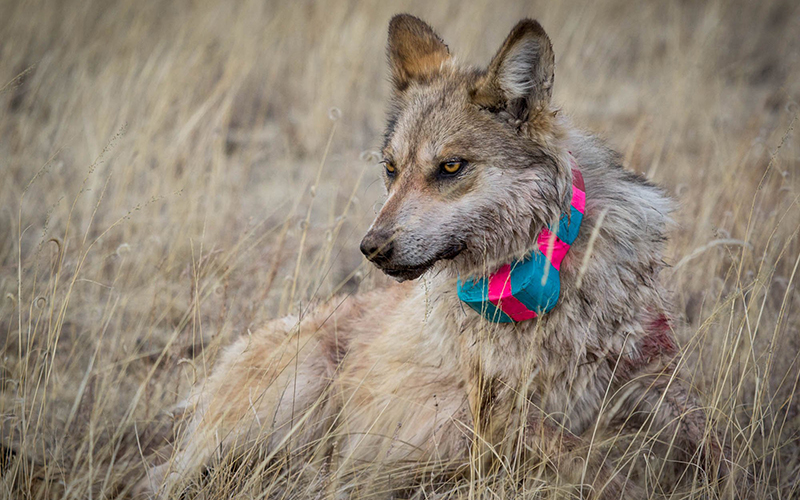
A Mexican wolf fitted with a radio collar is shown in this 2018 photo. Tracking the animals in the wild is part of the years-long effort to reintroduce the subspecies, which was at the brink of extinction. (File photo by Jenna Miller/Cronkite News)
PHOENIX – Mexican wolves nearly vanished from the Southwest in the early 1900s, but reintroduction efforts begun nearly 25 years ago have brought them back from the brink of extinction.
An updated recovery plan aims to further protect the endangered wolves through increased law enforcement, education and outreach to communities near where the wolves live. But the update has critics, who say it doesn’t go far enough.
The U.S. Fish and Wildlife Service’s final revised recovery plan, which was released Oct. 5, will step up law enforcement in places identified as hot spots for wolf deaths. The goal is to deter illegal kills, investigate wolves that have died and work with partners in other law enforcement agencies to protect the wolves.
Today, almost 200 Mexican wolves live in the wild along the Arizona-New Mexico state line – a small sliver of their historic range. Officials hope to celebrate the 25th anniversary of the reintroduction program next year with a population that exceeds 200 and has greater genetic diversity.
Cross-fostering is a major part of the Mexican wolf reintroduction effort. This involves breeding wolves in captivity and then placing their pups in wild dens. In addition, some wolves have been born in the wild since the program began.
“Human-caused mortality comes from a variety of different ways,” said Jim deVos, Arizona Game & Fish Department’s Mexican wolf coordinator. “Wolves get hit on the highway by cars passing, I think there’s probably some number of wolves that are shot accidentally and no doubt some of them are purposely.”
Fourteen wolves were killed illegally and six died in vehicle collisions in 2020 according to the Fish and Wildlife Service.
The first revision of the Mexican wolf recovery plan, in 2017, did not do enough to address human-caused deaths, deVos said. The second comes after the U.S. District Court of Arizona sent the 2017 plan back to a lower court to reconsider in October 2021.
DeVos said Mexican wolves, a subspecies of gray wolf, aren’t large and can be mistaken for coyotes. Because of this, Arizona Game & Fish is working on tools to help the public, including putting information about the wolves in the department’s annual Hunting Guidelines.
“We’re leaving them in sporting goods stores, places where hunters frequent,” deVos said. “The focus is, again identified within the recovery plan to increase law enforcement to increase public recreation, public education and trying to minimize the number of wolves that are killed.”
Aislinn Maestas with the Fish and Wildlife Service said in an email interview that implementing the updated recovery plan should lead to achieving its goals of establishing two populations distributed within the Mexican wolf’s historical range in Arizona, New Mexico, Texas and northern Mexico.
“Generally, we determine what types of actions will be helpful during a species’ recovery based on the threats impacting the species,” Maestas said. “Therefore, we developed actions in the plan to address these problems from several angles, such as increasing law enforcement to deter illegal take and education and outreach to increase public understanding of wolves.”
Maestas said recovery plans are revised if a court orders the revisions, in the case of the Mexican wolf, or if additional science about the species becomes available.
“The revised plan includes new site-specific management actions to address the threat of human-caused mortality, including illegal killing,” Maestas said. “The revisions address the part of the plan remanded by the court, and do not include any changes to the recovery strategy or criteria.”
Some organizations, such as the Center for Biological Diversity, want greater improvements to the recovery plan.
Michael Robison, a senior conservation advocate at the center, said Mexican wolves would lose their endangered status when they reach a certain number – a number he believes is too low. Mexican wolves would be delisted if the population maintains an average of 200 wolves over an eight year period. He also worries the wolves have a narrow distribution “that doesn’t utilize all the habitat that could help them recover.”

A Mexican gray wolf at the Sevilleta National Wildlife Refuge in New Mexico in 2010. The growing numbers of the endangered wolves have some ranchers concerned about depredation. (Photo by Jim Clark/U.S. Fish and Wildlife Service)
Robinson said he would like the plan to address livestock conflicts and “more effective” captive releases into the wild.
The latest revision includes “pasture rotations of livestock, the use of fladry around sensitive areas such as calving areas, fence repair and maintenance, hazing, and range riders,” according to a Fish and Wildlife news release.
Robinson said the best way to avoid conflicts between wolves and livestock is to remove livestock carcasses.
“The most important of them (revisions) is to require livestock owners to remove the carcasses of cattle or in some cases, horses that die of nonwolf causes, that die of disease or poisonous weeds or bad weather or, lightning strikes, other predators all these things that kill animals out there,” he said.
Wolves are likely to stay in the area where they find a dead animal, which could lead to the wolves killing a live animal, Robinson said.
More education about Mexican wolves is another thing Robinson would like to see from the revision. Increased education for those who live in areas near Mexican wolves is part of the latest recovery plan revisions.
“I’d like to see the Fish and Wildlife Service resume putting up the signs that warn people of the presence of wolves,” he said, “notify them that it’s illegal to shoot them in those circumstances, and even provide a little schematic, a little picture that shows the difference between a wolf and a coyote.”
The Mexican wolf recovery effort involves multiple agencies, with Fish and Wildlife in charge.
“A driven team of scientists, biologist, field staff from the Fish and Wildlife Service, Arizona Game & Fish Department, New Mexico Department of Game & Fish, USDA APHIS Wildlife Services, Forest Service and the White Mountain Apache Tribe all are working in concert towards that thing that we call recovery,” deVos said.
“In 1998, there were no wild wolves in the landscape,” deVos said. “We now have 196. This past year, we had 35 pairs that had litters that we know of. So, regardless of where you think the end game needs to be, and number, we’re making progress.”

